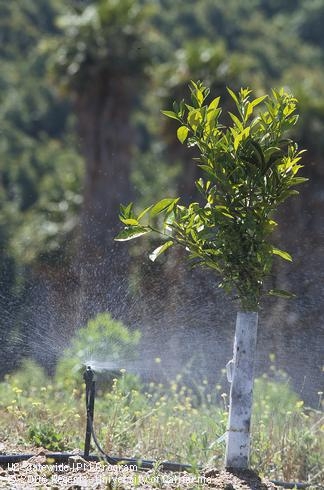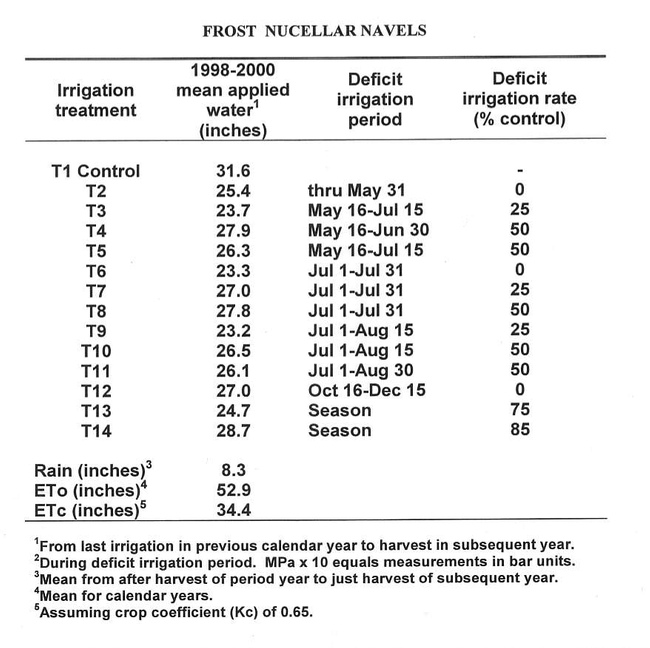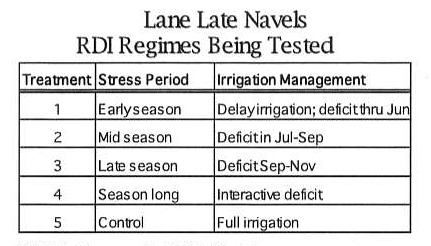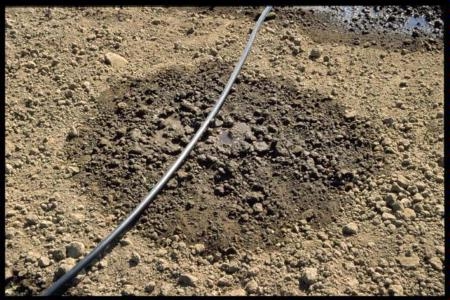
Posts Tagged: deficit
Strategizing for Water Cutbacks…Is there a Logical Method?
OK! Let's Strategize. There are four steps for everybody to consider, it doesn't matter if you have a backyard lawn and landscape or if you have 700 acres of avocados.
1. Maintenance: Irrigation System and Cultural Practices
2. Improve Irrigation Scheduling
3. Deficit Irrigation
4. Reduce Irrigated Area
1. Maintenace
a. Irrigation System.
- Fix leaks. Unfortunately, there are almost always leaks for all kinds of reasons. Pickers step on sprinklers, squirrels eat through polytube, branches drop on valves, coyote puppies like to chew….the system should be checked during every irrigation
- Drain the lines. At the beginning of each year every lateral line should be opened in order to drain the fine silt that builds up.
- Maintain or increase the uniformity of irrigation so that each tree or each area gets about the same amount of water. Common problems include different sized sprinklers on the same line or pressure differences in the lines. Where there are elevation changes, every line should have a pressure regulator, they come pre-set to 30 psi. Having all of your lines set up with pressure regulators is the only way you can get an even distribution of water to all of the trees, and it solves the problem of too much pressure at the bottom of the grove and not enough at the top.
- Clean the filters often. You don't have a filter because you think that the district water has already been filtered? Hah! What happens if there is a break in the line in the street and the line fills with dirt during the repairs? All of your sprinklers will soon be filled with dirt.
- Is water flow being reduced at the end of the lateral line? It could be because scaffold roots are growing old enough to pinch off the buried line. The only cure is to replace the line.
-
b. Cultural Management.
- Control the weeds because weeds can use a lot of water.
- Mulch? Mulching is good for increasing biological activity in the soil and reducing stress on the trees, but the mulch will not save a lot of water if you are irrigating often….the large evaporative surface in mulches causes a lot of water to evaporate if the mulch surface is kept wet through frequent irrigation. Mulches are more helpful in reducing water use if the trees are young and a lot of soil is exposed to direct sunlight.
2. Improve the Irrigation Scheduling.
- CIMIS will calculate the amount of water to apply in your grove based on last week’s water evapotranspiration (ET). You can get to CIMIS by using several methods; for avocado growers the best method is to use the irrigation calculator on the www.avocado.org website. If you need further instruction on this, you can call our office and ask for the Avocado Irrigation Calculator Step by Step paper. You need to know the application rater of your mini-sprinklers and the distribution uniformity of your grove’s irrigation system.
- CIMIS tells you how much water to apply, but you need tensiometers, soil probes or shovels to tell you when to water.
- “Smart Controllers” have been used successfully in landscape and we have used one very successfully in an avocado irrigation trial The one we used allowed us to enter the crop coefficient for avocado into the device, and daily ET information would come in via a cell phone connection. When the required ET (multiplied automatically by the crop coefficient) reached the critical level, the irrigation system would come on, and then shut down when the required amount had been applied. Increased precision can be obtained by fine tuning these devices with the irrigation system precipitation (application) rate.
-
3. Deficit Irrigation.
- Deficit irrigation is the practice of applying less water than the ET of the crop or plant materials. Deficit irrigation is useful for conserving water in woody landscape ornamentals and drought tolerant plants where crop yield is not an issue. Water conserved in these areas may be re-allocated to other areas on the farm or landscape.
- There hasn’t been enough research on deficit irrigation of avocado for us to comment. We suspect, however, that deficit irrigation will simply lead to dropped fruit and reduced yield.
- Stumping the avocado tree could be considered a form of deficit irrigation. In this case, the tree should be stumped in the spring, painted with white water-based paint to reflect heat, and the sprinkler can be capped for at least 2 months. As the tree starts to re-grow, some water should be added back, probably about 10-20% of the normal water use of a mature tree.
- Regulated Deficit Irrigation for Citrus is an important method for saving water, and in some cases will reduce puff and crease of the peel. In one orange trial done by Dr. David Goldhammer in the San Joaquin Valley, an application of 25% of ETc from mid-May to Mid July saved about 25% of applied water for the year and reduced crease by 67%, without appreciably reducing yield.
- 4.
- 3. Reduce Irrigated Area.
- Taking trees out of production. Trees that are chronically diseased and do not produce fruit (or the fruit is poor quality) should be taken out of production during this period. Also consider: trees in frosty areas, trees in wind-blown areas, trees near eucalyptus and other large trees that steal the water from the fruit trees.
- Changing crops. You may want to take out those Valencias during this period and replant to something that brings in more money, like seedless, easy-peeling mandarins. The young trees will be using a lot less water.
- Fallow Opportunities. You may decide to do some soil preparation, tillage or cultivation, or even soil solarization of non-irrigated areas.
We have found that this four step process is a logical way to achieve water cutbacks with least impact. It is possible to achieve a ten percent reduction in water by only improving irrigation system uniformity and scheduling procedures. Often, these two measures also result in better crop performance and reduced runoff. Reducing irrigated area or taking areas out of production should be a last resort and a well thought out decision. Plan for the future, hopefully water will be more available in future years.

citrus spray
Deficit Irrigation
Deficit irrigation research by Dr.David Goldhamer has yielded some interesting results in navel oranges. In the original trial on mature, vigorous Frost Nucellar navels on a sandy loam soil, applied water was reduced by varying amounts and at different times during the irrigation season depending upon the treatment imposed. Regulated deficit irrigation is applying a fixed % less than the full water requirement of the tree during a specific period in the irrigation season.
The fully irrigated control trees received a volume of water estimated to be the tree water requirements based upon size and current weather conditions –using the current water requirements of a pasture grass (Eto cimis station) multiplied by a crop factor for mature citrus which is 0.65. The objective of the trial was to determine if the volume of applied water could be reduced by varying amounts and at different times during the irrigation season compared to a fully irrigated control without a loss in yield or quality and perhaps improved peel appearance. Measurements were made of fruit growth during the season and of yield and fruit quality at harvest; the amount of water applied with each treatment was measured as well. Research conducted over the years has indicated that citrus was sensitive to reduced irrigation particularly at petal fall and during early fruit development with loss in yield or fruit size.

The current study indicated that where deficit irrigation was applied, a slowing in growth rate of the fruit was observed compared to the fully irrigated tree, but when full irrigation was resumed at the end of the treatment period, accelerated growth occurred compared to the control trees. Yield at harvest was not significantly different among any of the reduced irrigation treatments compared to the fully irrigated control trees. There was also no difference in number of fruit per tree or packable cartons among the treatments compared to the control. An additional result was that there was significantly less creasing of the peel in two of the treatments--T2 and T3-- compared to the fully irrigated trees. Both of these treatments imposed stress early in the season and reduced applied water by 6.2 and 7.9 inches, respectively. This equates to 19.6 and 22.8% less applied water than the fully irrigated control. This research demonstrated that less than the full water requirements of the tree can be applied at specific times during the fruit development period under controlled and known conditions without a loss in yield.
Ongoing research on Lane Late navels is being conducted with the object of reducing granulation by regulating fruit size for an optimum fruit size at harvest. Fruit held late for harvest frequently results in a significant portion of the fruit being large. Historically large fruit have a higher percentage of the fruit with granulation. This fruit may be less than optimum size (too large) for current market conditions as well. Based upon the previous regulated deficit irrigation study the object of the current trial is to regulate size based upon imposed stress by applying less than full irrigation during specific periods in the irrigation season that is early, mid and late season stress.

Less water is applied than required by a fully irrigated tree for the period, and growth of the fruit is monitored compared to the fully irrigated tree. Adjustments are made in applied water based upon the growth of the fruit in the stress tree as well as measured tree water status (pressure chamber) compared to the fully irrigated control. The same type of response to the deficit irrigation that occurred with the Frost Nucellar has been observed. A slowing of growth under the deficit irrigation, then accelerated growth with resumption of full irrigation. However, this study imposes stress over longer periods that the previous study and thus, the desired reductions in fruit size at harvest have occurred in all but the T1 treatments. The first year of the study, when fruit loads were relatively high, showed that early season stress reduced granulation (6.5% for all sizes vs. 17% for the control) with no effect on size. Continuous stress reduced both granulation (mean of 3.8 for all sizes vs. 17% for the control) and fruit size. In the second study year with lower fruit loads, there was no reduction in fruit load but fruit size was reduced to a greater extent in the mid, late summer, and continuous stress treatments. This reduced the percentage of unwanted very large size (24 and 32 count) fruit such that revenue to the grower was higher by from $1300 to $3000 per acre, depending on whether 24s and 32s were considered marketable.
Deficit irrigation imposes a level of stress on the tree related to the amount of water that the tree is shorted compared to a fully irrigated tree. The tolerance of the tree to this stress is related to the vigor of the tree, the period in the fruit development cycle, weather conditions, and how long the stress continues, and the magnitude of the stress. Under the conditions of these studies the level of stress imposed is carefully monitored and the deficit irrigation treatments are under known conditions and are carefully controlled. Where conditions are not known by the grower the trees may already be under some stress, the vigor of the trees may not be high; the irrigation system may not be uniform and therefore not delivering the expected volume. Attempting deficit irrigation under these circumstances runs the risk of reducing yield perhaps seriously as well as fruit size.

